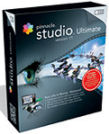The good news is that high-def video is now accessible to consumers -- with sub-$1000 camcorders, today's computer power, and now $100-range consumer video editing software.
![]() The new AVCHD consumer video format promises better compression than HDV, especially for camcorders recording to DVD disc and memory cards.
The new AVCHD consumer video format promises better compression than HDV, especially for camcorders recording to DVD disc and memory cards.
But just as with the adoption of previous new formats -- DV to MPEG-2 to MPEG-4 -- the software applications need time to catch up.
Not too surprisingly, I found varying support of AVCHD when I tested the current versions of today's consumer video editing tools. As a result, before you dive in to the new formats, you'll need to experiment before you settle on the right approach for your specific camcorder or collection of clips.
The best of the current bunch in my testing were:
 CyberLink PowerDVD Ultra
CyberLink PowerDVD Ultra
for playing high-def AVCHD and HDV files,
including fast response for skipping around in clips
(Find CyberLink PowerDVD on Amazon.com)
 Pinnacle Studio 11 Plus
Pinnacle Studio 11 Plus
for importing and editing AVCHD and HDV files
including mixing formats and resolution on the same timeline
(Find Pinnacle Studio 11 on Amazon.com)
(See below for a summary of all the applications)
The applications varied wildly in their handling of these formats: importing HDV and/or AVCHD; capturing from a camcorder over USB/Firewire and/or importing directly from files; importing individual sub-clips and/or the entire folder of shots; recognizing the file formats or requiring them to manually selected; and importing the files directly or needing them to be renamed (i.e., to .MPG).
The applications also varied wildly in their ability to process the formats in real-time: some allowed me to drag the slider and instantly scan back and forth in the clip, while others delayed for seconds when jumping to a new point in the clip, even when paused.
However, because these formats do require a bulked-up system, some of the applications are twitchy about running on possibly underpowered systems. For example, Pinnacle Studio displayed a warning on my ultraportable notebook, but then did its best to play the videos as well as it could. On the other hand, CyberLink PowerDVD flat-out refuses to run if it decides it does not like your system -- in my case rejecting a new quad-core workstation until I had downloaded an updated display driver. Other applications played and edited AVCHD fine on this system, but PowerDVD apparently was hard-coded to require only specific configurations.
Working with AVCHD
Summary of my results working with the latest versions of consumer video editing software:
(See the DVD Software Gallery and Video Editing Software Gallery for more information and links for these products.)
- CyberLink PowerDVD Ultra (version 7.2) - played HDV and AVCHD files with full interactivity during playback. Opens AVCHD folders as a disc, but requires individual files to be renamed .MPG.
- InterVideo WinDVD 8 - played individual AVCHD files, but not the full folder structure. No slider control to seek in the file, can only play and pause.
- Apple QuickTime Player (Windows version 7.2) - did not play sample HDV and AVCHD transport stream files.
- Apple iMovie '08 - supports AVCHD for a handful of camcorders -- check the Apple Support website for details.
- Pinnacle Studio 11 Plus - opens, plays, edits, and exports AVCHD video with other formats on the same timeline. Nice browser to view the folder structure with thumbnails.
- Ulead VideoStudio 11 Plus - imports AVCHD clips from a folder, but not individual files. Became sluggish when dealing with AVCHD files, taking seconds to switch tabs or move though the clips.
- Sony Vegas Movie Studio+DVD 8 Platinum Edition - supports AVCHD import and edit -- but only from Sony camcorders.
- CyberLink PowerDirector 6 - supports HDV but currently not AVCHD editing.
- Nero Vision 4 (part of the Nero 7 Ultra Edition Enhanced suite) - processed HDV files after renaming to .MPG, scanned though AVCHD files.
HDV and AVCHD
For high-def video, the first new consumer format was HDV, which was introduced in 2003 and is now reasonably supported in video applications. HDV was designed to fit HD video on DV tape, basically using MPEG-2 video in HD, and compressed to fit in DV data rates.
The next step in consumer video formats for HD was AVCHD, which was introduced in 2006, and takes advantage of the better compression capabilities of the newer MPEG-4 H.264/AVC format. AVCHD was originally targeted to camcorders that record to DVD discs (and is supported by the Blu-ray Disc format), and has been extended to camcorders that record to memory cards and hard disk.
However, MPEG-4 AVC is a complex format to work with, and high-res video adds even more data to process. These applications have other difficulties: The AVC format uses a messy folder format (see below) that combines the clunky DCIM folder structure of still photo cameras with an even more complex structure of PRIVATE / AVCHD / BDMV folders. And the files are not just simple MPEG program files -- they use the more "transport stream" format. Plus, there are two "flavors" of AVCHD, from Panasonic and Sony.
See Video Editing References for a glossary and references for video formats and standards.
AVCHD Folder Structure
 Sample AVCHD folder and file structure, from Panasonic HDC-SD1 and -SD5 AVCHD camcorders that record to SD memory cards:
Sample AVCHD folder and file structure, from Panasonic HDC-SD1 and -SD5 AVCHD camcorders that record to SD memory cards:
DCIM\ -- Photos
100CDPFP\
IMGAnnnn.JPG -- JPEG photos
MISC\
AUTPRINT.MRK
PRIVATE\
AVCHD\ -- Video
AVCHDTN\
THUMB.TID
THUMB.TDT
BDMV\ -- Video clips
INDEX.BDM
MOVIEOBJ.BDM
CLIPINF\
nnnnn.CPI
PLAYLIST\
nnnnn.MPL
STREAM\
nnnnn.MTS -- AVCHD video clips (MPEG Transport Stream)
